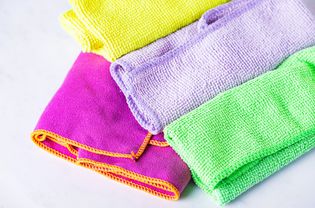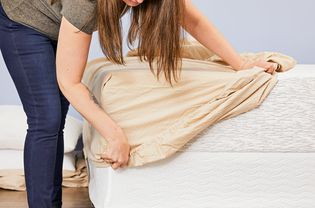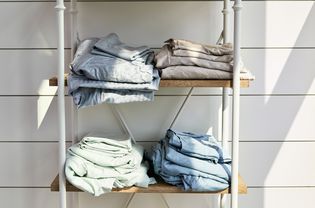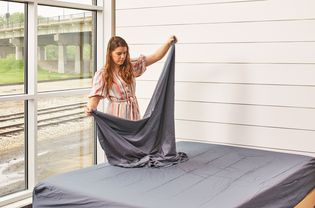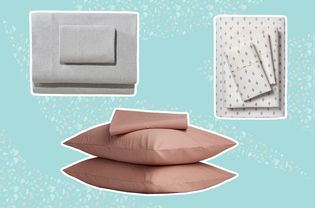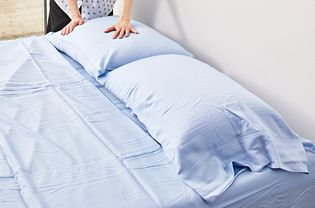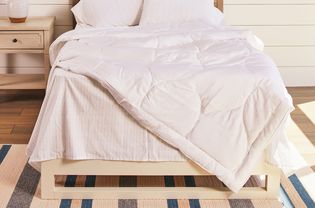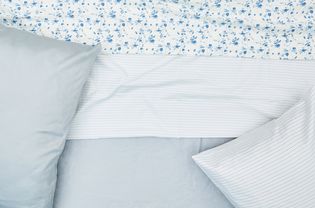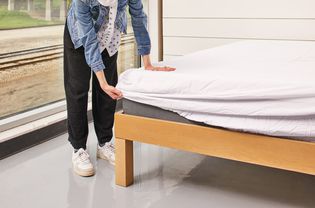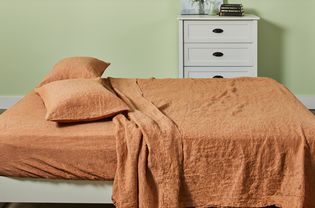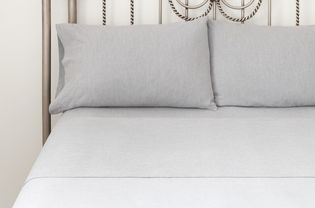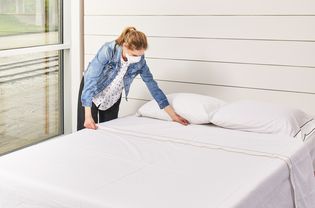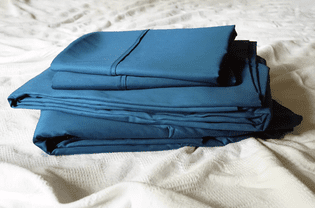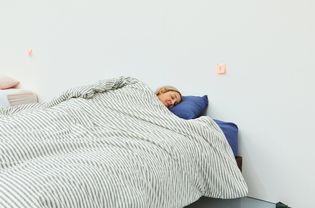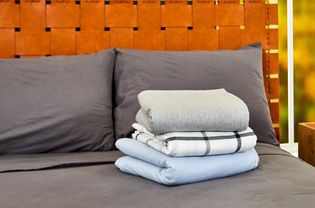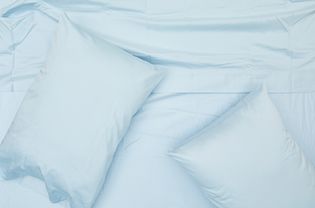Polyester and microfiber are both comfortable fabrics used for bed sheets. Still, there are a few key differences between these fabrics to know before choosing your next bedding set. Generally, microfiber sheets are better for breathability, and polyester is better for durability.
We talked to two bedding experts about the materials to find out everything you need to know—from choosing the right fabric to shopping for bedding. Read on to learn what they had to say.
What Is Polyester?
Polyester is a synthetic fabric made from petroleum-based products that's inexpensive and easy to clean. Its downsides include its rougher texture, and it's not very breathable, which is uncomfortable for hot sleepers.
What Is Microfiber?
Microfiber is like a polyester upgrade. It's another synthetic material made from a blend of polyester and nylon. Its composition makes it a little pricier, breathable, and water-absorbent. It's also smooth, softer, and lightweight.
Pros and Cons
Polyester Sheets
"Polyester is a synthetic fabric made from petroleum and petroleum-derived products," according to Torun Hannam, founder of The Bamboo Shop. "Polyester fabric is cheap to make and one of the world's most popular textiles. [However], in recent decades, the popularity of 100% polyester in clothing and bedding has decreased in favor of mixing it with natural fabrics such as cotton to add softness and breathability."
More affordable
Longer lifespan
Not very breathable
Has a more synthetic feel
Microfiber Sheets
The fabric has two main types of weaves: flatweave and split weave. And you can often tell the difference by touch. Split weave tends to stick to your fingers more. In a split weave, the fibers are split to create a finer, multi-strand material that's more water-absorbent. "This is why split weave microfiber is popular in activewear, as well as in cleaning products such as mops and cleaning cloths," shares Hannam.
More breathable
Feels slightly less synthetic
Feels softer and silkier compared to polyester
Stronger (split-weave)
Slightly more expensive
Not as durable
Can create static cling
Stains easier
Polyester vs. Microfiber for Bed Sheets
Popularity
Regarding go-to fabrics, polyester is the most common and has been widely used since the 1950s. However, microfiber has been gaining popularity as another low-cost option or alternative to polyester or cotton.
Quality
Microfiber is considered an upgrade from polyester since it is polyester blended with other fibers. However, the question of quality is subjective since the two match up similarly on many points. For some, having a softer feel is more important than lasting longer.
Comfort
Microfiber is softer and more comfortable than polyester. Polyester has a rougher, more artificial feel due to the weave. It can still be smooth but doesn't get the luxurious softness that microfiber can achieve.
According to Hannam, "Microfiber and polyester are similar in many ways. Microfiber is usually made from polyester, nylon, polyamide, and other additives. The main difference is that microfiber, as the name indicates, is made from ultra-fine fibers of 0.7 deniers or less. To compare, a strand of silk is about one denier, about a fifth of the diameter of a human hair."
Durability
Microfiber is a more substantial material. "Microfiber beddings are stronger than polyester bedding because of the split weaving method," shares Stephen Light, Co-Owner of Nolah Mattress. "The split weave allows microfiber fabrics to boast a higher tensile strength than traditional polyester fabrics."
However, polyester outlasts microfiber in terms of wear and tear and resistance. Microfiber has thinner fibers that are not as sturdy as polyester.
Cleaning
Polyester is an easy-to-launder fabric. It resists wrinkles and shrinkage, making the material easy to wash and essential for everyday sheets.
Breathability
If you're a hot sleeper or someone who lives in a warm place, polyester probably isn't the best choice. But, if you need something to warm or insulate you, polyester can help retain your natural body heat.
"Polyester is well known for its lack of breathability (just think back to those clingy 70s shirts)," says Hannam, "[This makes] it a terrible choice for bedding. Microfiber is more breathable than polyester, but it cannot rival natural materials such as cotton, linen, or bamboo."
Eco-friendliness
Neither of the materials is eco-friendly. Both textiles contribute to pollution. According to Hannam, "Microfiber has the added disadvantage of contributing to the growing problem of microplastics in our oceans and waterways."
Cost
"The price point for microfiber fabric is higher than for polyester as the manufacturing process involved in producing the ultra-thin fibers of microfiber is much more complex," shares Hannam. "Both materials are cheaper to produce than natural fibers, though."
Polyester and Microfiber Sheets: Which Is Better?
Depending on where you live and the temperatures, you will have different preferences and needs regarding your sheets. Moisture-wicking and general warmth and cooling properties are important if you're a sweaty sleeper. Polyester might be too hot in that case.
If you're looking for something softer and lightweight, microfiber may be the go-to but don't forget this synthetic material's "stickiness" or static. Polyester is the way to go if your two primary needs are a low price and a long-lasting sheet set.
Hannam advises prioritizing breathability if you're looking for the perfect bedsheet. "Look for 100% natural materials and avoid synthetic materials and blends which can make you sweat and overheat," she shares. If breathability and sleeping cool concern you, consider a switch to natural materials like cotton, linen, or bamboo.
-
Which is the cooler option, polyester or microfiber?
For hot sleepers, microfiber is a cooler option since the fibers are not woven as closely together.
-
Is 100% microfiber the same as 100% polyester?
Microfiber and polyester are not the same. However, some lower-quality microfiber can be made of 100% polyester.
-
Is polyester good for comforters?
Polyester is favored for cold-season comforters because it is good at insulating heat.
:max_bytes(150000):strip_icc()/MarisaDonnelly-Headshot-85a98276fc7146b196bdcee93c12c182-a5f6d5b3f3134df09a7449e0b24885d3.jpg)

